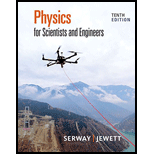
The weight of a rectangular block of low-density material is 15.0 N. With a thin string, the center of the horizontal bottom face of the block is tied to the bottom of a beaker partly filled with water. When 25.0% of the block’s volume is submerged, the tension in the string is 10.0 N. (a) Find the buoyant force on the block. (b) Oil of density 800 kg/m3 is now steadily added to the beaker, forming a layer above the water and surrounding the block. The oil exerts forces on each of the four sidewalls of the block that the oil touches. What are the directions of these forces? (c) What happens to the string tension as the oil is added? Explain how the oil has this effect on the string tension. (d) The string breaks when its tension reaches 60.0 N. At this moment, 25.0% of the block’s volume is still below the water line. What additional fraction of the block’s volume is below the top surface of the oil?
Trending nowThis is a popular solution!

Chapter 14 Solutions
Physics for Scientists and Engineers
Additional Science Textbook Solutions
General, Organic, and Biological Chemistry - 4th edition
Organic Chemistry
Chemistry & Chemical Reactivity
Loose Leaf For Integrated Principles Of Zoology
Fundamentals Of Thermodynamics
Genetics: From Genes to Genomes
- Mick and Rick are twins born on Earth in the year 2175. Rick grows up to be an Earth-bound robotics technician while Mick becomes an intergalactic astronaut. Mick leaves the Earth on his first space mission in the year 2200 and travels, according to his clock, for 10 years at a speed of 0.75c. Unfortunately, at this point in his journey, the structure of his ship undergoes mechanical breakdown and the ship explodes. How old is Rick when his brother dies?arrow_forwardHi, I have canceled, why did you charge me again?arrow_forwardNo chatgpt pls will upvotearrow_forward
 Principles of Physics: A Calculus-Based TextPhysicsISBN:9781133104261Author:Raymond A. Serway, John W. JewettPublisher:Cengage Learning
Principles of Physics: A Calculus-Based TextPhysicsISBN:9781133104261Author:Raymond A. Serway, John W. JewettPublisher:Cengage Learning Physics for Scientists and Engineers: Foundations...PhysicsISBN:9781133939146Author:Katz, Debora M.Publisher:Cengage Learning
Physics for Scientists and Engineers: Foundations...PhysicsISBN:9781133939146Author:Katz, Debora M.Publisher:Cengage Learning University Physics Volume 1PhysicsISBN:9781938168277Author:William Moebs, Samuel J. Ling, Jeff SannyPublisher:OpenStax - Rice University
University Physics Volume 1PhysicsISBN:9781938168277Author:William Moebs, Samuel J. Ling, Jeff SannyPublisher:OpenStax - Rice University Physics for Scientists and EngineersPhysicsISBN:9781337553278Author:Raymond A. Serway, John W. JewettPublisher:Cengage Learning
Physics for Scientists and EngineersPhysicsISBN:9781337553278Author:Raymond A. Serway, John W. JewettPublisher:Cengage Learning Physics for Scientists and Engineers with Modern ...PhysicsISBN:9781337553292Author:Raymond A. Serway, John W. JewettPublisher:Cengage Learning
Physics for Scientists and Engineers with Modern ...PhysicsISBN:9781337553292Author:Raymond A. Serway, John W. JewettPublisher:Cengage Learning Physics for Scientists and Engineers, Technology ...PhysicsISBN:9781305116399Author:Raymond A. Serway, John W. JewettPublisher:Cengage Learning
Physics for Scientists and Engineers, Technology ...PhysicsISBN:9781305116399Author:Raymond A. Serway, John W. JewettPublisher:Cengage Learning





